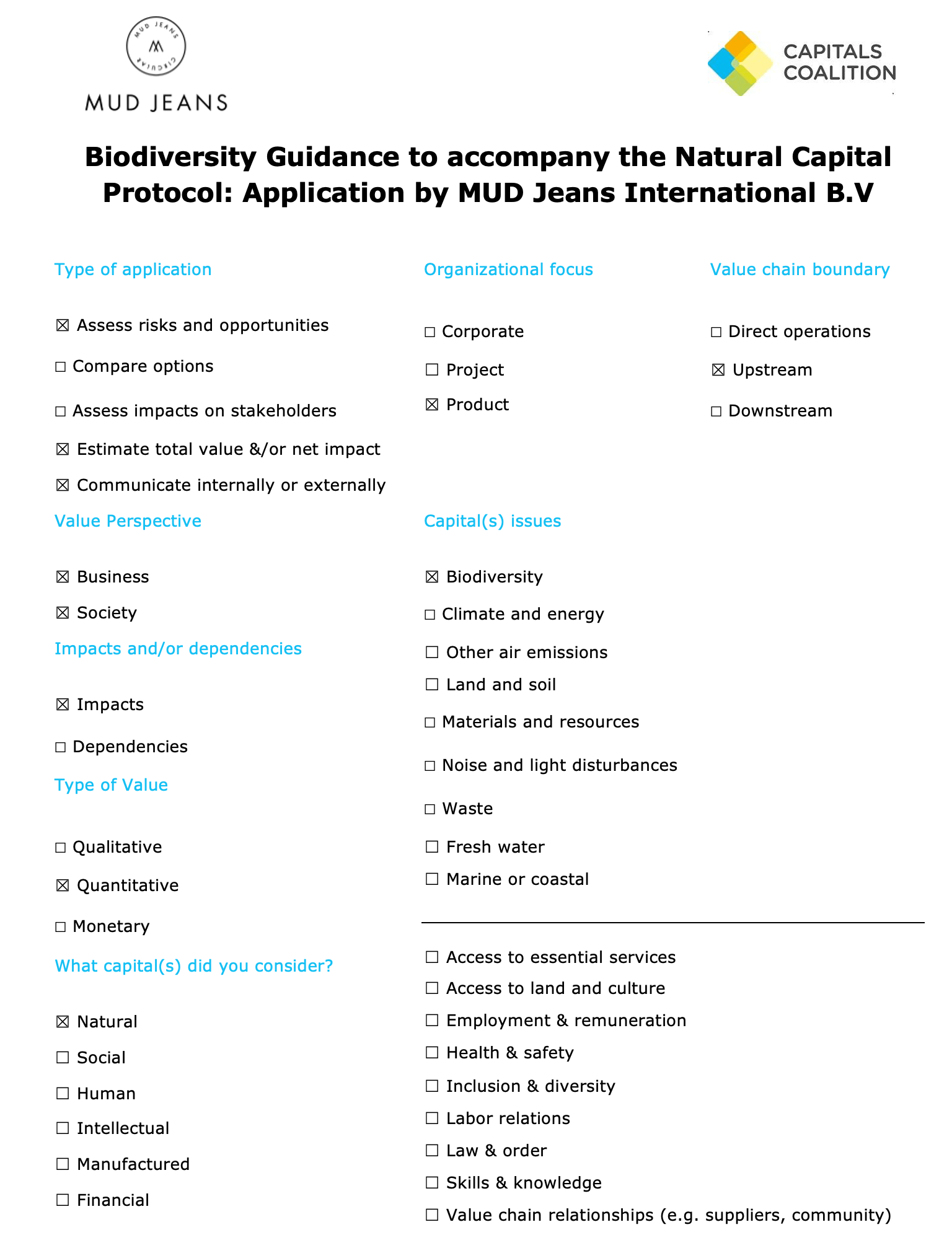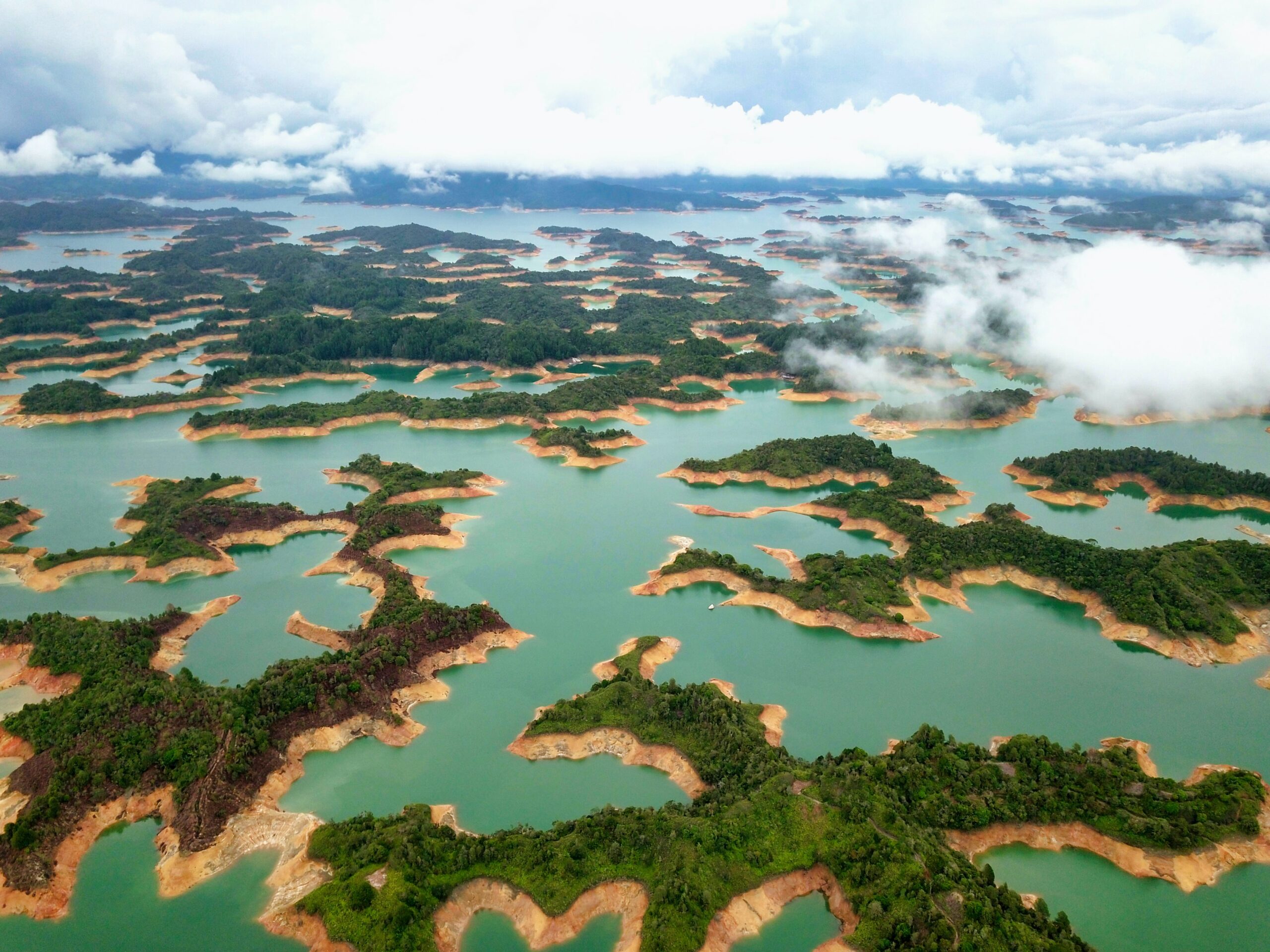The organization in brief:
MUD Jeans is a circular denim brand. Circularity is at the core of our business. Inspired by the need to demonstrate that there is an alternative to the fast fashion industry, and that it is possible to live in a world without waste, our CEO Bert Van Son, took on the challenge to lead by example and create the first fully circular denim brand. All areas of our business are driven by circularity. Through the Lease and Jeans model, our customers are able to lease their jeans, and enjoy a new product without environmental anxiety. Through the lease concept, our customers can borrow our material in the shape of Jeans and return it once they are done using it. Depending on the condition of the returned jeans, they are either upcycled or recycled and re-incorporated into a new pair of jeans. Through this approach, no jeans end up in landfill and MUD Jeans slowly begins to incentivize a world without waste.
In this pilot MUD Jeans collaborated with Ecochain. Ecochain is an environmental intelligence platform that supports companies in measuring their environmental impact.
Why was this undertaken?
MUD Jeans recently completed its second Life Cycle Analysis (LCA) with the support of Ecochain. Through this LCA we were able to further analyze our environmental impact from Cradle to Gate, measure our progress and set future targets. In this LCA we expanded our variables from water and CO2 consumption, to also include land occupation, energy, and environmental cost. This already told us a great deal about our impact and how it compared to industry standard. For example, it revealed that compared to the industry standard we consumer 92% less water and 70% less CO2 in production.
While we understood that tracking our environmental impact in this manner is already indirectly touching on biodiversity we wanted to go further and have a variable that specifically depicts it. The motivation is three fold. First, biodiversity is a variable that very clearly depicts the impact that a company is having on the planet. With the objective to demonstrate that there is an alternative to fast fashion, we wanted clear biodiversity data that depicted the difference between industry standard and a circular denim business. This data would also help us understand our current impact and how to improve in the future.
Second, based on a small survey that was conduct in late 2019, biodiversity ranked the highest when we asked our customers what environmental impact details they wanted to know about our products. At MUD Jeans we strive to be fully transparent and provide our customers with all details and information about our products so they can make an empowered decision.
Third, biodiversity loss and ecosystem collapse, while not widely spoken about, is one of the biggest threats facing humanity in the next decade. Starting with the Planetary Boundaries report of 2009 and even the 2020 Global Fashion Agenda, the conservation of biodiversity has been spoken of with great urgency. The fashion industry due to its use and dependency on raw materials such as cotton, leather, and gold, will need to take serious action in this regard. With this in mind, MUD Jeans, aiming to lead by example, collaborated with Ecochain to develop a biodiversity variable for the LCA and measure the impact of MUD Jeans against industry standard. We hope that by sharing our knowledge and experience we can inspire others to take similar steps.
What was the scope?
The primary material used in our jeans is cotton. We use 5 fabrics in our production and they all range in the following composition:
- 40% post-consumer recycled cotton, and 60% GOTS Certified Organic Cotton
- 23% post-consumer recycled cotton, 2% elastane, 75% GOTS Certified Cotton
Cotton would therefore be our largest dependency. However, this biodiversity study captured biodiversity impacts from cradle to gate. Thus, this study includes the raw materials (cotton, elastan), processing of these raw materials (spinning, weaving, dyeing), confection of these materials into jeans (stitching, sewing, washing), fabric losses and transport.
How did you measure and value your impacts and/or dependencies?
LCA end point modelling was used to measure the difference between ‘business as usual’ and the MUD Jeans value chain. One of the endpoints named ‘damage to ecosystems’ provides an indication of the number of species lost per year. This indicator is therefore not a ‘direct measurement’, but an indicative measure, based on the emissions calculated from the LCA.
Much of the data had already been collected during the LCA process. To obtain the biodiversity variable, Ecochain applied the ReCiPe impact methodology. The data used in the LCA and in the biodiversity study consisted of primary data collected from our suppliers and background data from Ecoinvent.
Using available data for organic cotton, from a study prepared for the C&A foundation the objective was to create a comparison of the biodiversity impact between MUD Jeans products and the industry standard. Industry standards are based on using general cotton and production techniques whereas MUD Jeans using GOTS certified cotton, post-consumer recycled cotton and innovative environmentally friendly production techniques.
What was the Biodiversity Guidance used for?
As a business, the guidance material provided a good overview of potential methodologies to consider. Given that there is not yet a standardized approach to measuring biodiversity, the document provided reinforcement and trust in the selection of the ReCiPe methodology.
What were the results?
Two MUD Jeans styles (the Regular Dunn stone black and the Skinny Hazzen stone black) were used to calculate the biodiversity impact. In our last LCA we observed that the impact across styles does not vary greatly, which is why focusing only on these two styles gave us an indication of the impact across the whole collection.
The data demonstrated that on average MUD Jeans has a biodiversity footprint that is 43% lower than industry standard.
The table below depicts the biodiversity footprint breakdown of MUD Jean Regular Dunn in comparison to the industry standard.

It is exciting to see the strong difference in impact between the industry standard and MUD Jeans. It is no surprise to expect a significant impact difference between standard cotton and organic cotton, as the former consists of using pesticides and insecticides as well as other non-sustainable agricultural practices that have a serious impact on biodiversity. The use or recycled cotton naturally also has an impact as it lowers the dependency and use of virgin materials. Individually as a brand however, the study also highlighted areas of potential improvement along the entire production process. While we were proud to see a significant difference in cotton impact, we want to continue to improve in this area by increasing the use of recycled content. Additionally, however, the study brought to our attention the need to focus on the impact of ironing, sewing, spinning and stitching.
What was the outcome of the assessment, and what impact did it have?
In the 2019 Sustainability report, one main goal was to develop a biodiversity variable in the year 2020. Having achieved that, the next step is to develop a wider overview of all styles, and a more in-depth analysis of impact at the production level. Additionally, now that we have the variable, the 2020 Sustainability report will also set targets specifically on this variable. In this process we ensure that biodiversity is continuously measured and forms part of the larger discussion of product development and material selection in the future. Because MUD Jeans is circular and already working with high environmental standards, decision making always encompasses these values. However, with data we will be able to share more concretely the benefit of using the materials we carefully choose, and our improvement across the years. We hope that with this information we can build trust with our customers and also inspire other brands to do the same.
MUD Jeans is currently working on a project in collaboration with Saxion University, Recover and Circle Economy to create a pair of jeans that is 100% made from post-consumer recycled cotton. Through this project we will aim to lower our biodiversity impact significantly.
What were the learnings?
As a brand we were happy to achieve our objective of calculating the biodiversity impact of our jeans. As mentioned, we feel that this is a variable that our customers can more easily relate to. Due to the support we had from Ecochain and their high-level expertise, we did not face any obstacles. Given that we had already completed an LCA and the fact that there was easy access to both organic and standard cotton data made this analysis very easy. Simultaneously, given that our main and single commodity is cotton, we knew to expect the majority of the impact there. Due to this experience there was no major learnings.
As an exercise, I personally learned about the variety of approaches that can be used to calculate biodiversity. This variety of approaches may pose a challenge in the future as more companies set to measure their impact. Understanding the limitations of each approach, and correctly communicating them will be key.
Next steps:
As mentioned above, the objective is to continue to measure our impact, set targets for the future, and share our findings and experience with others.
![]()













